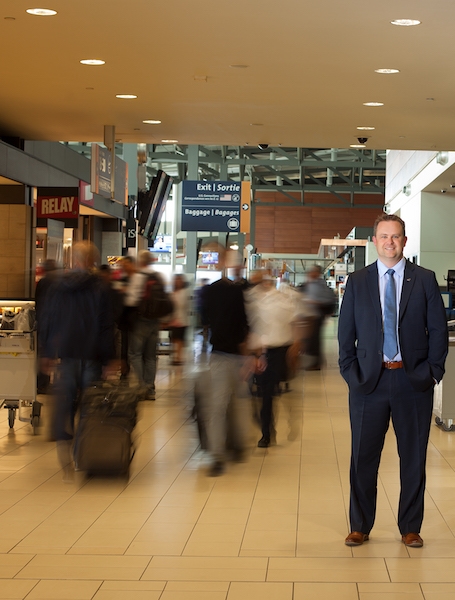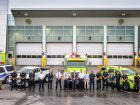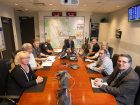
Security Director of the Year 2017 — Takeoff Speed
Neil Sutton
News james armstrong security director of the yearNo matter how much you learn, how much you train, no matter your experience or years in the field, events that require the intervention of a skilled security professional are — almost by definition — unpredictable.
 James Armstrong
James Armstrong James Armstrong has essentially taken this worldview and made it a strength. Armstrong is the vice-president of security, emergency management and customer transportation for the Ottawa Macdonald-Cartier International Airport Authority. He is also Security Director of the Year for 2017, an annual award, sponsored by Anixter Canada, given to a professional who has displayed exemplary characteristics, as recognized by a group of his peers.
But what Armstrong really is, is a person who sees the value of a holistic approach, of using all eyes and ears at his disposal. Basically, doing what it takes to get ready for the improbable, but not impossible.
Armstrong is, by most measures, a newcomer to the field of professional security, but he spent more than 20 years preparing for the role by serving in the armed forces. He began his service career as a military police officer, but was soon recruited into the intelligence world and ultimately retired from duty as an intelligence officer (Lieutenant Colonel). During that time, he served multiple tours of duty in Afghanistan, the Middle East and the U.S.
Even as a retiree, Armstrong couldn’t leave the military behind altogether. He joined the reserves, and to this day works in their intelligence division.
But Armstrong was also looking for a new experience after his service. “The stars kind of aligned when I saw the position available for the Ottawa Airport,” he says. “My dad was a pilot in the Air Force, so I’ve grown up around airports my whole life. In my own military career, I spent a lot of time in the Air Force as well. I always wanted to work at an airport or for an airline.”
Armstrong started working at the Ottawa Airport as its director of security in 2015, and was promoted to his current VP status less than a year later.
When he was first hired, Armstrong says the airport’s CEO Mark Laroche told him, “‘This won’t be as busy or exciting as Afghanistan,’ but I will have to say that it is… even more so.”
Armstrong joined the airport at a uniquely busy time for the city, as it readied for the major celebrations that marked Canada’s 150th anniversary, as well as the Ottawa 2017 events that are still going on — “we’re still kind of midway through that process,” he says.
With Ottawa as a focal point for the national birthday, the city experienced a major uptick in traffic and hosted a higher number of VIPs than usual. (Canada Day was also followed by a major 4th of July celebration hosted at the U.S. embassy in Ottawa.)
“When the 150th came up, we worked very closely with the city and Federal Government to prepare for that,” says Armstrong. “A lot of that involved collaboration with security, policing and intelligence agencies. The big kick-off for us was preparing with the city for an emergency exercise. The city conducted an emergency exercise across the whole city, so we took part in that.”
Armstrong is a big believer in exercises that involve as many of the airport’s tenants as possible. Since coming on board, he has instituted several major programs that emphasize this holistic approach.
“We call it the ‘curb to cabin’ security approach,” he says. “That term is often used in the aviation industry to talk about a passenger’s experience, but we look at that in terms of security.”
A new insider threat program, for example, has provided Armstrong a more comprehensive view of what’s going on — or could be going on — inside the airport.
“You’re seeing security threats now where some of the threats come from within,” he explains. “They could be terrorist threats, but you could also have things such as workplace violence. In an airport, you could also have things like smuggling and other criminal activities. The insider threat in an airport crosses over a lot of spectrum.”
Armstrong has developed workshops in collaboration with the Ottawa Police, the RCMP, Public Safety Canada and Transport Canada, amongst others, to train supervisors that work at the airport, including airline workers, ground handlers and retailers. The program stresses the importance of observing behavioural patterns and trains staff to look for visual cues.
“Are people stressed? Do they have financial concerns? Have you seen a change in their behaviour? Anything that stands out — we started to train them on that,” says Armstrong. Also, “how to report it and what could occur after they report it.”
More than 5,000 people work at the airport, in addition to the almost five million passengers that pass through its facilities annually. “An airport is such a big organization, it’s like a mini city,” he says.
“There’s so many facets and so many people through here… you’re always evolving and adapting. This program has opened our eyes to a number of things we need to monitor a lot closer.”
Armstrong says security has been able to realize cost savings within its own department by finding efficiencies, reducing overlap and pursuing projects like the integration of the radio system used by City of Ottawa first responders and the airport. Over the past two years alone, an estimated 15-20 per cent of the overall security budget has been saved. “We’ve found a lot of efficiencies. Those efficiencies have allowed us to reinvest critical funds into other security programs,” he says.
Armstrong runs an additional 20-25 workshops a year just on active shooter training and makes sure all tenants are actively engaged with security on a daily basis. The security department operates a “see something, say something” policy with tenants and encourages them to offer tips, no matter how minor they may seem at the time. “We don’t care how small it is; we’ll go check it out,” he says.
“We’ve had staff find tens of thousands of dollars in cash and they turn it in, because they embrace that community concept that we’ve developed with the security program. We want people to see this as their house. They’re protecting their home as well. From the cleaners to the ground handlers to the airline staff. The ‘see something, say something’ program we have with our tenants — it’s fantastic.”
In addition to the numerous smaller exercises and ongoing security programs, Armstrong’s team plans one major exercise a year.
Last year it was “Exercise Dark Knight,” held in October. A simulated terror attack, it was coordinated with Ottawa first responders, as well as the RCMP, the Canada Border Services Agency, Public Safety Canada and other major security stakeholders, including U.S. partners. Dark Knight focused on the threats posed by improvised explosive devices (IEDs) and suicide bombers. Using actors, an event was planned that tested the airport’s response to several attacks staged simultaneously. Armstrong says he’s a big believer in creating scenarios that go beyond most people’s perception of what such an attack would look like. The more you train, the less likely you are to be shocked by the unthinkable.
“You can design a million different [security] plans, train everybody to those plans, but the minute the event happens, it may not go according to that plan. And we don’t want people to freeze,” he says.
When Mark Laroche was in the process of hiring a new security director three years ago, he wanted someone who was “camera-ready” — an individual who could step into the role and handle practically anything, come what may.
Laroche gave Armstrong a vote of confidence only nine months into the role by promoting him to vice-president. The promotion was conferred at the time in response to the situation created by a taxi driver labour dispute, but Laroche says he wanted his security department to occupy a bigger seat at the C-suite table.
“A vice-president of security in any organization almost has to be a pest. He has to make the whole senior management team aware that there are security issues almost every day. If he doesn’t do that, he’s almost not doing his job,” says Laroche.
Armstrong credits his senior leader as one of those CEOs who “gets it,” who not only understands the value of security but will go out of his way to support it. He also knows that not everyone who works in professional security is quite so lucky.
For his part, Laroche says he knows that security requires “a lot of resources for something that’s not going to happen 99.999 per cent of the time” but he says he typically puts the challenge back on Armstrong.
“I say, ‘you don’t have to convince me of the necessity. You have to tell me how you’re going to get it done.’ That gives him the liberty to be creative and find solutions. I think that’s the role of the CEO — make sure your VPs have enough room to operate, get out of the way, and let them do their job,” says Laroche.
When Armstrong was first notified that he was selected as this year’s Security Director of the Year, his initial response was to accept on behalf of the airport rather than himself. Armstrong works with a team of 32 full-time employees including security and emergency staff, the airport’s fire service and police detachment, as well as a canine unit (which recently beat out 20 other police and corrections units to win the Canadian Law Enforcement Detection Dog Championships). He also oversees the airport’s security contractor, Paladin Security, and maintains relationships with Ottawa Police, firefighters, the airport’s parking services, its taxi contractor, as well as numerous stakeholders including CATSA, the CBSA, U.S. Customs, and others.
Armstrong was recently responsible for sending Paladin Security station manager Don Rolland on a Disney Quality Service Program, often considered the gold standard for customer service training. For Armstrong, the goal is two-fold: yes, improve customer service and imbue that throughout the organization, but also take advantage of the security implications. A security team that is fully engaged with the airport’s customers is also more informed.
“A lot of people’s first contact is going to be with the Paladin Security team,” says Armstrong. “We want them to focus on the customer service aspect, because when you’re engaged with somebody and you’re talking to them, you can detect anomalies a lot better than you can staring at them from a distance with a walkie-talkie in your hand.”
Next up? Armstrong is working on a drone detection program.
“There’s a lot of moving pieces here and it never sleeps. It’s a very busy place. I knew it was complex, but I didn’t know it was that complex,” he says. “It’s probably the busiest job I’ve ever had, but it’s also the most rewarding. It’s a place where you can actually see the tangible results of the team’s efforts and that’s important.”
Print this page
Advertisement
- A look at attacks where vehicles have been used as weapons
- University of the Fraser Valley investigating breach of student information



Leave a Reply